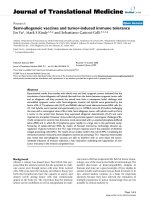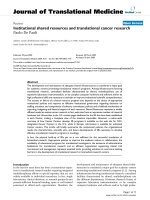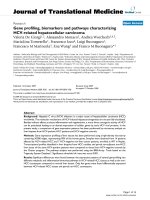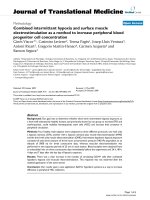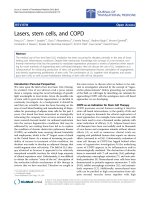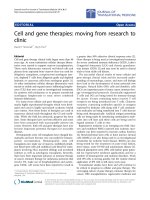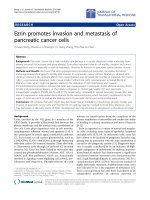báo cáo hóa học:" Ovarian hyperstimulation syndrome and prophylactic human embryo cryopreservation: analysis of reproductive outcome following thawed embryo transfer" pdf
Bạn đang xem bản rút gọn của tài liệu. Xem và tải ngay bản đầy đủ của tài liệu tại đây (322.04 KB, 6 trang )
BioMed Central
Page 1 of 6
(page number not for citation purposes)
Journal of Ovarian Research
Open Access
Research
Ovarian hyperstimulation syndrome and prophylactic human
embryo cryopreservation: analysis of reproductive outcome
following thawed embryo transfer
Eric Scott Sills*
1
, Laura J McLoughlin
2
, Marc G Genton
3
, David J Walsh
1
,
Graham D Coull
1
and Anthony PH Walsh
1
Address:
1
Sims International Fertility Clinic/The Sims Institute, Dublin, Ireland,
2
Faculty of Medical Sciences, University of Newcastle, Newcastle-
upon-Tyne, UK and
3
Department of Econometrics, University of Geneva, Geneva, Switzerland
Email: Eric Scott Sills* - ; Laura J McLoughlin - ;
Marc G Genton - ; David J Walsh - ; Graham D Coull - ;
Anthony PH Walsh -
* Corresponding author
Abstract
Objective: To review utilisation of elective embryo cryopreservation in the expectant
management of patients at risk for developing ovarian hyperstimulation syndrome (OHSS), and
report on reproductive outcome following transfer of thawed embryos.
Materials and methods: Medical records were reviewed for patients undergoing IVF from 2000–
2008 to identify cases at risk for OHSS where cryopreservation was electively performed on all
embryos at the 2 pn stage. Patient age, total number of oocytes retrieved, number of 2 pn embryos
cryopreserved, interval between retrieval and thaw/transfer, number (and developmental stage) of
embryos transferred (ET), and delivery rate after IVF were recorded for all patients.
Results: From a total of 2892 IVF cycles undertaken during the study period, 51 IVF cases (1.8%)
were noted where follicle number exceeded 20 and pelvic fluid collection was present. Elective
embryo freeze was performed as OHSS prophylaxis in each instance. Mean (± SD) age of these
patients was 32 ± 3.8 yrs. Average number of oocytes retrieved in this group was 23 ± 8.7, which
after fertilisation yielded an average of 14 ± 5.7 embryos cryopreserved per patient. Thaw and ET
was performed an average of 115 ± 65 d (range 30–377 d) after oocyte retrieval with a mean of 2
± 0.6 embryos transferred. Grow-out to blastocyst stage was achieved in 88.2% of cases. Delivery/
livebirth rate was 33.3% per initiated cycle and 43.6% per transfer. Non-transferred blastocysts
remained in cryostorage for 24 of 51 patients (46.1%) after ET, with an average of 3 ± 3 blastocysts
refrozen per patient.
Conclusion: OHSS prophylaxis was used in 1.8% of IVF cycles at this institution; no serious OHSS
complications were encountered during the study period. Management based on elective 2 pn
embryo cryopreservation with subsequent thaw and grow-out to blastocyst stage for transfer did
not appear to compromise embryo viability or overall reproductive outcome. For these patients,
immediate elective embryo cryopreservation and delay of ET by as little as 30 d allowed for
satisfactory conclusion of the IVF sequence, yielding a livebirth-delivery rate (per ET) >40%.
Published: 6 November 2008
Journal of Ovarian Research 2008, 1:7 doi:10.1186/1757-2215-1-7
Received: 5 September 2008
Accepted: 6 November 2008
This article is available from: />© 2008 Sills et al; licensee BioMed Central Ltd.
This is an Open Access article distributed under the terms of the Creative Commons Attribution License ( />),
which permits unrestricted use, distribution, and reproduction in any medium, provided the original work is properly cited.
Journal of Ovarian Research 2008, 1:7 />Page 2 of 6
(page number not for citation purposes)
Introduction
Ovarian hyperstimulation syndrome (OHSS) is the most
serious consequence of ovulation induction and in vitro
fertilisation (IVF), potentially resulting in death in its
extreme manifestation [1]. How best to manage this con-
dition has been the subject of considerable study, with
primary emphasis on risk recognition before commencing
the IVF stimulation sequence [2,3]. The exact etiology of
OHSS remains unknown. Since pregnancy can worsen
OHSS, embryo transfer is sometimes intentionally post-
poned by electively freezing embryos until symptoms
have resolved and the clinical picture improves [1]. In this
study, data collected at one IVF referral centre during a
nine-year period were used to assess a conservative strat-
egy for OHSS prophylaxis and to investigate how empiric
embryo cryopreservation and delayed transfer might
impact reproductive outcome.
Materials and methods
Patient selection and study design
Patient records for all ovulation induction performed at
the Sims International Fertility Clinic were retrospectively
reviewed for the period 2000–2008, including all IVF
patients (n = 2892). No case of OHSS was diagnosed in
patients undergoing gonadotropin treatment for IVF. In
this population, OHSS prophylaxis using elective embryo
cryopreservation was instituted when the number of folli-
cles with mean diameter ≥ 15 mm exceeded 20 [1] and
when an intraperitoneal pelvic fluid collection was
present measuring >5 cm (in any diameter) on transvagi-
nal ultrasound. Serum oestradiol measurements were not
obtained for every patient for the entire duration of the
study period, so this parameter was not included for anal-
ysis.
All IVF patients included for study received a focused
physical examination, and saline infusion sonogram,
which were normal before initiating gonadotropin ther-
apy. Controlled ovarian hyperstimulation regimens were
developed from factors including historical response to
medications, patient age, BMI and ovarian reserve assess-
ment. Pituitary downregulation was achieved with oral
contraceptives and GnRH agonist, followed by daily
administration of gonadotropins (daily dose ≤ 150 IU/d)
with periodic monitoring as previously described [4].
Treatment continued until adequate ovarian response was
attained, defined as at least three follicles with mean
diameter ≥ 17 mm. Transvaginal sonogram-guided oocyte
retrieval was accomplished 36 h after subcutaneous
administration of 10,000 IU hCG. Immediately after
retrieval oocyte-cumulus complexes were placed into Uni-
versal IVF medium (MediCult; Jyllinge, Denmark), with
insemination (including ICSI) also carried out using this
reagent under washed liquid paraffin oil (MediCult, Den-
mark). Fertilisation was assessed after 16–18 h and was
considered normal when two distinct pronuclei were
noted.
For patients considered at risk for OHSS (based on criteria
outlined above), extensive and immediate counselling
was provided during the IVF cycle to review the poten-
tially grave risks associated with fresh embryo transfer (as
originally planned at cycle initiation). Since fresh transfer
was not regarded as safe when OHSS might develop, alter-
nate options of cycle cancellation and elective embryo cry-
opreservation were carefully outlined. While complete
cycle cancellation was uniformly offered, no patients at
risk for OHSS elected to do this during the study interval.
Consequently, these cases were managed via elective
embryo freeze (see Figure 1). Once this "freeze all" deci-
sion was made, this was documented and communicated
to embryology staff. There were no additional OHSS cases
that developed after embryo transfer who were not previ-
ously recognised during follicular recruitment and ovula-
tion induction with gonadotropins.
Embryo cryopreservation sequence
Following confirmation of normal fertilisation by the
presence of two distinct pronuclei, embryos were placed
in cryoprotectant (Embryo Freezing Pack, MediCult, Den-
mark) at room temperature and cooled to -7°C at a rate of
2°C/min. Manual seeding followed after 5 min, then the
embryos were cooled from -7°C to -30°C at a rate of
0.3°C/min. The final rapid cooling step brought the
embryos from -30°C to -190°C at 50 C/min; they were
next transferred to liquid N
2
for long-term storage and
maintained at -196°C.
Thaw, culture & transfer protocols
2 pn embryos were removed from liquid N
2
storage and
kept at room temperature ×30 sec before being placed in
H
2
O bath at 30°C for 1 min. Embryos were placed in 1,2
propanediol/sucrose-based thaw media (Embryo Thaw-
ing Pack, MediCult, Denmark) at room temperature for a
total of 20 min. Culture was maintained to day five in
microdrops of BlastAssist media I and II (MediCult, Den-
mark) under washed paraffin oil in a 5%CO
2
+ 5%O
2
atmosphere at 95% humidity. Embryos were assessed
daily for cell number, degree of fragmentation, and com-
paction. Day five blastocysts selected for in utero transfer
generally demonstrated a well-defined inner cell mass and
highly cellular, expanding trophoectoderm. Blastocysts
were loaded into an ET catheter (K-Soft-5000 Catheter;
Cook Medical Inc., Spencer, Indiana USA), and all trans-
fers occurred under direct transabdominal sonogram
guidance.
Secondary freeze for non-transferred blastocysts
Supernumary blastocysts selected for (repeat) cryopreser-
vation were incubated in 5–6% CO
2
atmosphere at 37°C
Journal of Ovarian Research 2008, 1:7 />Page 3 of 6
(page number not for citation purposes)
× 2 h, then placed in cryoprotectant (BlastFreeze, Medi-
Cult, Denmark) cooled to -6°C at a rate of 2°C/min. After
manual seeding, embryo temperature was taken from -
6°C to -40°C at 0.3°C/min. Final rapid cooling of blasto-
cysts from -40°C to -150°C at 35°C/min was followed by
transfer to long-term storage in liquid N
2
at -196°C.
Outcomes reporting and statistical analysis
Primary endpoints of the study were patient age, total
number of oocytes retrieved, number of 2 pn embryos cry-
opreserved, interval between retrieval and thaw/transfer,
number (and developmental stage) of embryos trans-
ferred (ET), and livebirth-delivery rate. All data were tabu-
lated as mean ± SD. Patients were periodically followed
during pregnancy, or contact was established with their
delivering obstetrician to determine delivery status. In the
event that contact could not be made and delivery status
remained unknown, this was also noted in the record.
Results
A total of 2892 IVF cycles proceeded to oocyte retrieval
during the study period. Of these, 51 patients (1.8%) were
judged to be at risk for developing OHSS and prophylactic
embryo freezing was performed. While none of these
patients qualified for fresh embryo transfer according to
medical centre policy, there were some patients requesting
elective embryo cryopreservation who were not at risk for
OHSS. Reasons for empiric embryo cryopreservation in
these cases included incidental surgery unrelated to fertil-
ity, diagnosis of malignancy, and divorce. Reproductive
Schematic for prophylactic embryo cryopreservation at the 2pn stage, followed by extended culture to blastocyst stage (B) and subsequent transfer (ET). Non-transferred blastocysts are re-frozen for subsequent use (lower left).Figure 1
Schematic for prophylactic embryo cryopreservation at the 2pn stage, followed by extended culture to blasto-
cyst stage (B) and subsequent transfer (ET). Non-transferred blastocysts are re-frozen for subsequent use
(lower left).
Journal of Ovarian Research 2008, 1:7 />Page 4 of 6
(page number not for citation purposes)
outcomes for these patients not considered at-risk for
OHSS were excluded from the calculation of delivery rates
in this study.
The mean (± SD) age of patients at risk for OHSS during
the study period was 32 ± 3.8 yrs. Both ovaries were
present and morphologically normal at baseline for all
patients at risk for OHSS. All patients underwent ultra-
sound-guided transvaginal oocyte retrieval at our facility
without incident; the average number of oocytes retrieved
per patient was 23 ± 8.7. After fertilisation either by con-
ventional insemination or ICSI, an average of 14 ± 5.7 2
pn embryos were cryopreserved per patient. Embryo cryo-
preservation was successfully carried out for approxi-
mately 61% of the total number of retrieved oocytes in
this population.
Over the next 30 d, patients at risk for OHSS were period-
ically re-evaluated after elective cryopreservation of their
embryos to document clinical improvement and resolu-
tion of symptoms. When there was no laboratory evi-
dence of haemoconcentration, pelvic fluid collections had
cleared, and ovarian quiescence was noted via ultrasound,
it was considered safe to resume the IVF treatment
sequence: thaw and grow-out to blastocyst stage was car-
ried out. Development to blastocyst stage was achieved for
88.2% of cases, but when the cohort of thawed embryos
did not advance to blastocyst stage the most developed
embryos were transferred. This affected six cases after
thaw, five of whom had day three embryos and one case
where a 'mixed transfer' consisting of one morula + one
blastocyst was performed. Embryo transfer was performed
an average of 115 ± 65 d (range 30–377 d) after oocyte
retrieval. In these patients at risk for OHSS, the mean
number of embryos transferred was 2 ± 0.6. For 24 of
these (46.1%), supernumary blastocysts remained after
transfer and were returned to cryostorage.
For patients considered at risk for OHSS where elective 2
pn embryo cryopreservation was performed, the live birth
delivery rate was 33.3% (17/51) per initiated cycle and
43.6% (17/39) per transfer. No twin or triplet deliveries
occurred in this series. Follow-up with patients after deliv-
ery identified no long-term OHSS sequela, and there were
no malformations or developmental anomalies reported
among offspring.
Discussion
Ovarian hyperstimulation syndrome (OHSS) is a poten-
tially fatal iatrogenic condition resulting from excessive
stimulation of the ovaries [5]. The vast majority of OHSS
develops in the setting of injectable gonadotrophins used
in IVF, although in the absence of proper monitoring oral
clomiphene treatment can also result in massive ovarian
hyperstimulation necessitating surgical removal of the
ovary [6].
According to the World Health Organization (WHO),
severe OHSS develops in 0.2–1% of all stimulated ART
cycles [7]. Several methods to prevent OHSS have been
advocated including elective embryo cryopreservation,
using low-dose hCG or GnRH-agonist for triggering
oocyte maturation, "coasting" gonadotropin use, and
cycle cancellation. To date, no single investigation has
compared patient outcome and pregnancy rates among
these varied interventions. In the present study, we imple-
mented elective embryo freezing as an OHSS prophylactic
measure in 1.8% of our IVF patients, a figure parallel to
previous reports of actual OHSS incidence [8,9]. The
pathophysiology of OHSS is complex; it likely involves a
disruption of inflammatory processes normally evoking
ovulation. The characteristic capillary extravasation of
OHSS seems to be mediated by interactions of prolactin,
prostaglandins, the ovarian prorenin-renin-angiotensin
system, vascular endothelial growth factor (VEGF), ang-
iogenin, the kinin-kallikrein system, selectins, von Wille-
brand factor, and/or endothelin [2]. The altered vascular
permeability of OHSS may also be modulated by VE-cad-
herin [10], an interendothelial adhesion molecule or
serum soluble ICAM-1 [11]. Of note, significantly higher
IL-18 levels have been detected in the serum and extravas-
cular fluids of patients with severe OHSS compared to
non-OHSS controls [12].
When a patent is considered at risk for OHSS at our centre,
we do not typically proceed with fresh embryo transfer
(ET). During patient counselling, we explain that the strat-
egy of empiric embryo freezing to minimise OHSS risk is
not new [1,3,13,14], but has considerably lower risk than
proceeding with fresh ET as originally planned. The
rationale for delaying ET derives from the intent to delay
pregnancy, since hCG increases VEGF which in turn facil-
itates the endothelial permeability associated with OHSS
[15]. One of the first prospective studies to demonstrate
the therapeutic benefit of elective early embryo cryop-
reservation in OHSS patients randomised subjects to
undergo either fresh ET or receive delayed ET after cryop-
reservation (and thaw) of all embryos. No cases of OHSS
developed in the setting of elective embryo freeze; preg-
nancy rates were comparable between the two groups
[16].
OHSS risk is not always eliminated by elective freezing of
embryos. An earlier review of precautionary cryopreserva-
tion of all embryos at the 2 pn stage noted that OHSS
developed anyway in 27% of cases [13]. Some have spec-
ulated that elective embryo freezing may reduce the sever-
ity – but not lower the incidence of – symptomatic OHSS
[14].
Journal of Ovarian Research 2008, 1:7 />Page 5 of 6
(page number not for citation purposes)
One unexpected finding from the present study was the
large variation in time interval between oocyte retrieval
and thaw/transfer among patients at risk for OHSS, which
ranged from 30 to 377 days. While neither duration of cry-
ostorage nor type of ovulation induction protocol has
been found to affect reproductive outcome in IVF [17,18],
we nevertheless remain curious why any IVF patient
would wait for more than a year to initiate a thaw-transfer
sequence – risk of OHSS notwithstanding. It is our belief
that such extended (>90 d) delays are a function of patient
scheduling preferences rather than medical factors, but
the question forms the basis of ongoing research here. As
our data show, elective embryo cryopreservation may lead
to considerable delay in treatment (and consequently
postpones the potential for pregnancy) and many patients
at risk for OHSS are understandably discouraged by the
prospect of elective embryo freeze. However, patients
should be made aware that while live birth delivery rates
among IVF patients at risk for OHSS can be impressive
[19], the dangers accompanying OHSS are not be under-
estimated. For example, one series in Ireland recently
demonstrated a 4% case fatality rate for the condition [9].
Our study has several limitations which should be
acknowledged. We focused more on OHSS prevention
rather than development of the condition itself. Serum
oestradiol has been used as a marker for OHSS risk for
many years [1,2,5,7,9], but this method of screening was
not regularly available at our institution throughout the
nine-year study period and thus was not part of this anal-
ysis. Additionally, the role of paracentesis or albumin/
hespan infusion could not be specifically studied in this
report because medical records were not electronically
searchable for these terms throughout the study period.
While 2 pn embryos for cryopreservation were produced
from approximately 61% of retrieved oocytes in this
series, our OHSS cases were not stratified according to
ICSI vs. conventional insemination. However, previous
research has suggested that pregnancy rates after cryop-
reservation of 2 pn embryos are not impacted by fertilisa-
tion method [20]. Our retrospective study also did not
have a control group, so it is unknown how many patients
might have developed OHSS if a fresh transfer had been
performed. However, it is reasonable to conclude that
some OHSS cases would have been expected from this
high-risk population.
In conclusion, this descriptive study finds conservative
application of elective embryo cryopreservation to be a
useful component of OHSS prophylaxis. High delivery
rates are typical among women at risk of OHSS who
undergo elective embryo cryopreservation with deferred
thaw/transfer, and our outcomes data support this finding
as well. While serum oestradiol determinations can be
helpful in OHSS surveillance, this report shows that
screening based on clinical parameters can also be effec-
tive. Further studies are planned to refine specific factors
that might be useful in prediction of OHSS risk, with a
view to optimise clinical management of this important
and potentially dangerous condition.
Competing interests
The authors declare that they have no competing interests.
Authors' contributions
ESS and LJM collected data for the study and prepared the
original manuscripts; MGG provided design input and
statistical analysis; GDC organised the embryology labo-
ratory components and provided data on gametes and
reproductive outcome; DJW and APHW supervised the
project and directed the research. All authors approved the
final manuscript.
References
1. Tiitinen A, Husa LM, Tulppala M, Simberg N, Seppala M: The effect
of cryopreservation in prevention of ovarian hyperstimula-
tion syndrome. BJOG 1995, 102:326-9.
2. Delvigne A, Rozenberg S: Systematic review of data concerning
etiopathology of ovarian hyperstimulation syndrome. Int J
Fertil Womens Med 2002, 47:211-26.
3. Amso NN, Ahuja KK, Morris N, Shaw RW: The management of
predicted ovarian hyperstimulation syndrome involving
gonadotropin-releasing hormone analog with elective cryo-
preservation of all pre-embryos. Fertil Steril 1990, 53:1087-90.
4. Sills ES, Schattman GL, Veeck LL, Liu HC, Prasad M, Rosenwaks Z:
Characteristics of consecutive in vitro fertilization cycles
among patients treated with follicle-stimulating hormone
(FSH) and human menopausal gonadotropin versus FSH
alone. Fertil Steril 1998, 69:831-5.
5. D'Angelo A, Amso N: Embryo freezing for preventing ovarian
hyperstimulation syndrome. Cochrane Database Syst Rev 2007,
18(3):CD002806.
6. Sills ES, Poynor EA, Moomjy M: Ovarian hyperstimulation and
oophorectomy following accidental daily clomiphene citrate
use over three consecutive months. Reprod Toxicol 2000,
14:541-3.
7. Binder H, Dittrich R, Einhaus F, Krieg J, Müller A, Strauss R, Beckmann
MW, Cupisti S: Update on ovarian hyperstimulation syn-
drome: Part 1 – Incidence and pathogenesis. Int J Fertil Womens
Med 2007, 52:11-26.
8. Pattinson HA, Hignett M, Dunphy BC, Fleetham JA: Outcome of
thaw embryo transfer after cryopreservation of all embryos
in patients at risk of ovarian hyperstimulation syndrome. Fer-
til Steril 1994, 62:1192-6.
9. Mocanu E, Redmond ML, Hennelly B, Collins C, Harrison R: Odds of
ovarian hyperstimulation syndrome (OHSS) – time for reas-
sessment. Hum Fertil (Camb) 2007, 10:175-81.
10. Villasante A, Pacheco A, Ruiz A, Pellicer A, Garcia-Velasco JA:
Vas-
cular endothelial cadherin regulates vascular permeability:
Implications for ovarian hyperstimulation syndrome. J Clin
Endocrinol Metab 2007, 92:314-21.
11. Abramov Y, Schenker JG, Lewin A, Kafka I, Jaffe H, Barak V: Soluble
ICAM-1 and E-selectin levels correlate with clinical and bio-
logical aspects of severe ovarian hyperstimulation syn-
drome. Fertil Steril 2001, 76:51-7.
12. Barak V, Elchalal U, Edelstein M, Kalickman I, Lewin A, Abramov Y:
Interleukin-18 levels correlate with severe ovarian hyper-
stimulation syndrome. Fertil Steril 2004, 82:415-20.
13. Wada I, Matson PL, Troup SA, Hughes S, Buck P, Lieberman BA: Out-
come of treatment subsequent to the elective cryopreserva-
tion of all embryos from women at risk of the ovarian
hyperstimulation syndrome. Hum Reprod 1992, 7:962-6.
14. Wada I, Matson PL, Troup SA, Morroll DR, Hunt L, Lieberman BA:
Does elective cryopreservation of all embryos from women
Publish with Bio Med Central and every
scientist can read your work free of charge
"BioMed Central will be the most significant development for
disseminating the results of biomedical research in our lifetime."
Sir Paul Nurse, Cancer Research UK
Your research papers will be:
available free of charge to the entire biomedical community
peer reviewed and published immediately upon acceptance
cited in PubMed and archived on PubMed Central
yours — you keep the copyright
Submit your manuscript here:
/>BioMedcentral
Journal of Ovarian Research 2008, 1:7 />Page 6 of 6
(page number not for citation purposes)
at risk of ovarian hyperstimulation syndrome reduce the
incidence of the condition? BJOG 1993, 100:265-9.
15. Villasante A, Pacheco A, Pau E, Ruiz A, Pellicer A, Garcia-Velasco JA:
Soluble vascular endothelial-cadherin levels correlate with
clinical and biological aspects of severe ovarian hyperstimu-
lation syndrome. Hum Reprod 2008, 23:662-7.
16. Ferraretti AP, Gianaroli L, Magli C, Fortini D, Selman HA, Feliciani E:
Elective cryopreservation of all pronucleate embryos in
women at risk of ovarian hyperstimulation syndrome: effi-
cacy and safety. Hum Reprod 1999, 14:1457-60.
17. Veeck LL, Amundson CH, Brothman LJ, DeScisciolo C, Maloney MK,
Muasher SJ, Jones HW Jr: Significantly enhanced pregnancy
rates per cycle through cryopreservation and thaw of pronu-
clear stage oocytes. Fertil Steril 1993, 59:1202-7.
18. Lin YP, Cassidenti DL, Chacon RR, Soubra SS, Rosen GF, Yee B: Suc-
cessful implantation of frozen sibling embryos is influenced
by the outcome of the cycle from which they were derived.
Fertil Steril 1995, 63:262-7.
19. Queenan JT Jr, Veeck LL, Toner JP, Oehninger S, Muasher SJ: Cryo-
preservation of all prezygotes in patients at risk of severe
hyperstimulation does not eliminate the symptoms, but the
chances of pregnancy are excellent with subsequent frozen-
thaw transfers. Hum Reprod 1997, 12:1573-6.
20. Damario MA, Hammitt DG, Galantis TM, Session DR, Dumesic DA:
Pronuclear stage cryopreservation after intracytoplasmic
sperm injection and conventional IVF: implications for tim-
ing of the freeze. Fertil Steril 1999, 72:1049-54.
